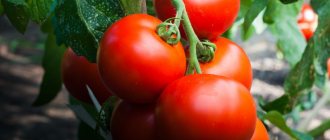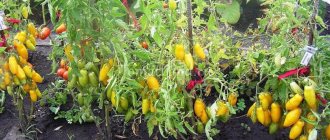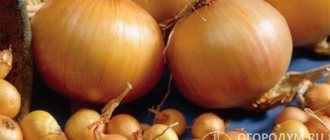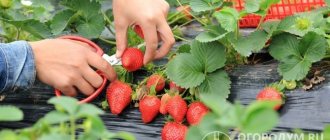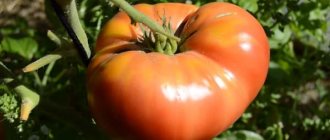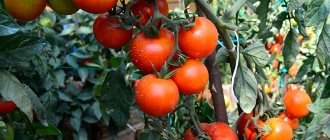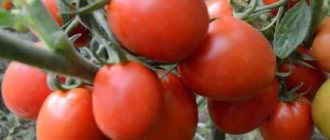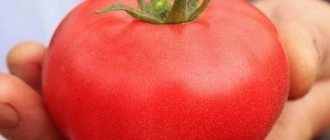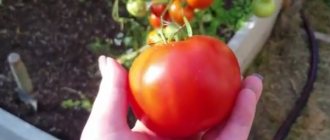Description of the variety
This variety was bred back in 1986 in the city of Volgograd, and it was included in the State Register at the same time. Breeders specifically created this variety for subsequent use in conservation. All summer residents fell in love with this variety, which is distinguished by its unpretentiousness and good yield.
Novice tomatoes are varieties with an average ripening period (114-123 days) and average yields. This variety is limited in growth and is not stamped, so it is tied up. The plant is intended for cultivation mainly in open beds and film shelters. But sometimes (due to determinacy) it is grown on the balcony, in large peas.
Description of the bush
Since novice tomatoes are a plant with a determinate type of bush, the plant grows low in height: up to 85 cm. There are few leaves on the plant, so the bush does not grow. The color of the leaves is dark green, with barely noticeable fluff. There are also few branches and stems on the bush. Despite the fact that the plant is not very tall, it has a powerful root system that can firmly anchor itself in the soil. The plant tolerates drought well and has excellent immunity.
Description of fruits
The berries of this variety are loved by all housewives and summer residents. Of course: the shape of the fruit is a paradise for a perfectionist: ideal, even and smooth. The weight of a ripe berry reaches approximately 80-110 grams. The fruits ripen almost simultaneously. But there is no need to rejoice: the fruiting of a newbie is not very long.
As you can see, the fruit is large, but not excessively. This allows it to be used entirely in pickling. When ripe, the color of tomatoes is bright red, sometimes closer to orange. The taste is good, typically tomato. The rating of fresh fruits during tasting was 4.6 points, canned ones - 4.4 points.
Existing subspecies
This variety has two “brothers”: pink and deluxe. They are also included in the register of breeding achievements. The first subspecies has practically no differences from the “father”, but the second is famous for the unusual shape of its fruits. By the way, they like to grow unusually shaped fruits in China and Japan.
Newbie pink
Judging by the reviews, the newcomer tomato of the pink subspecies is no different from the original type. Only the color of the berries - pale red, delicate shade. Of course, the color of the berries cannot be called typically pink. Breeders could use a little more effort before breeding a newbie tomato and calling it “pink.” Or they could at least improve the properties. And so - just color and that's it. The characteristics and taste are the same. The variety was bred 15 years ago.
Newbie Deluxe
But another variety of tomato, novice, has different characteristics. Its brother, with the elite name “deluxe”, is a complete development of a well-known agricultural company that supplies seeds to most stores. This variety is a late ripening variety. The fruits have an interesting shape, reminiscent of a cube. The weight is almost the same as the original type: up to 110 grams. The bush type is determinate. The purpose of the deluxe variety is universal, that is, the fruits are suitable for absolutely any application: juices, sauces, homemade preparations, etc.
Features of planting and growing at home on the balcony
There are tomato varieties specifically designed for growing on the balcony, for example, Balcony Miracle, Balcony Bonsai or Pinocchio. The newcomer is not included in this list, but some amateurs, taking advantage of the unpretentiousness of the variety and the compactness of the bush, plant it at home. The technique of planting and growing tomatoes on a balcony differs little from that in a garden, but they must try to create natural conditions.
Growing seedlings is carried out in exactly the same way as for ordinary beds, but, depending on where the balcony is located and whether it is glazed, sowing seeds can be done significantly earlier than usual. However, a glazed balcony on the south side can also play a disservice: if the temperature rises significantly above 30°C, the tomatoes feel bad, and when it approaches 40°C they can drop their flowers and die altogether. Therefore, when growing on a balcony, care is added to maintain an acceptable temperature by ventilating the mini-garden in a timely manner.
Balcony growing tomatoes is somewhere between a hobby and a necessity, but some hobbyists get good results
Ready seedlings are transplanted into any containers of sufficient size (ideally, each bush should have at least a bucket of good soil mixture). The transplanted seedlings are shaded from the bright rays of the sun for several days, which require adaptation. Further care is the same as in open ground. Of course, for irrigation they take water from the tap, so it must first be left standing, preferably at least a day.
All basic operations (loosening, fertilizing, pinching, etc.) are required, but artificial pollination can also be added to them: insects rarely fly onto the balcony. Ovary, which is sprayed on bushes, can also help. You have to treat the plants with Bordeaux mixture a couple of times a season: the risk of contracting diseases in an enclosed space is very high. In general, it is worth saying that only “landless” nature lovers have to grow tomatoes on the balcony: doing it in natural conditions is much more convenient and reliable.
Video: tomatoes on the balcony
Characteristic
It’s not for nothing that the tomato variety with the childish name “novichok” is so beloved by many gardeners. Not only does it require little care, but it also has excellent immunity to most nightshade diseases. But prevention is worth doing. Due to the small growth, the need for pinching the bush disappears by itself. Also, the bush does not need a garter, but most gardeners still tie the plant to wooden pegs.
Advantages and disadvantages
This variety has significantly more advantages than disadvantages. The only negative they talk about is that the skin is too thick. It would be a stretch to call this a disadvantage. But the advantages speak for themselves:
- Easy to care for, grows well on its own. This does not affect the yield. The plant does not need any special soil; it will establish itself perfectly and take all the necessary substances;
- The bush tolerates dry times by taking moisture from the soil and storing it in its roots and stems;
- Due to the compactness of the plants, per square meter. meter plant several pieces at once;
- The taste of ripe berries is simply wonderful, rich, with barely pronounced sourness, the pulp of the fruit is juicy and fleshy;
- The variety bears fruit well even when the weather outside is not warm and periodic with rain. Even in bad weather, the plant consistently produces a crop;
- The bush does not need pinching;
- The variety is practically disease free. The novice tomato is also not affected by harmful insects;
- Novichok is not a hybrid, but an independent variety. Therefore, if you want to grow this variety, buy a ripe fruit at the market and use it to collect seeds;
- Due to their thick skin, tomatoes are perfectly stored; they can be transported over long distances and not worry: they won’t crack.
Productivity
Despite the determinant type of bush, the plant shows high productivity. About 2-3 kg of juicy fruits are collected from one small bush. If the thickening is dense, the harvest reaches 14 kg. In a greenhouse, the yield is much higher.
Growing regions
Since tomatoes love light, almost any variety is best grown in regions with a warm climate. The description of the tomato suggests that it is preferable for a beginner to grow it where there is no temperature difference. This tomato variety (based on state register data) is intended for cultivation in the Nizhnevolzhsky region. But the newcomer, as some reviews from summer residents say, can be grown anywhere - it adapts everywhere. Suitable regions:
- North Caucasus;
- Middle Volga;
- Nizhnevolzhsky;
- Far East.
Productivity
Novichok fruits are harvested as they ripen. Not only red and pink fruits are harvested, but also unripe ones with an orange color. Tomatoes of this variety will delight any vegetable grower with the friendly yield of the harvest. Depending on the planting scheme, you can get about 12 kg of smooth cream per square meter of area. And from a bush - 2 kg or more. Tomatoes will last longer if picked in the morning and immediately placed in a box in a single layer with the stems facing up.
Novichok tomatoes can be used both for salads and for making sauces and ketchups. But most of all this variety is suitable for preservation.
The yield of Novichok tomato is up to 2 kg per bush
If you really want the fruits to ripen earlier, you can use a sharp knife to make a through slit of about 5 cm on the stem in the area of the root collar and insert a wooden toothpick or other wooden pin with a diameter of 0.5 cm into it.
Growing seedlings
Like most tomatoes that are grown from seedlings, this variety is no exception. The procedure is simple: sow the seeds, monitor the first shoots, moisten the soil in time and plant it in a permanent place at the right time.
Landing dates
For experienced summer residents, it is not difficult to grow seedlings from seeds. Every gardener knows that the right time for sowing is the beginning of spring. Of course, it all depends on the variety. But the standard time for planting seeds in the soil is a couple of months before the intended planting in the soil. As a rule, this is the end of the first month of spring or the beginning of the second.
Seed preparation
Inexperienced gardeners, when they are just starting to grow their first seedlings, are disappointed when they planted the entire package of seeds, but only a few sprouted. Therefore, summer residents have long come up with an interesting and simple way to check. Thanks to it, you can immediately find out which seeds are suitable for planting and which are not.
To do this, place new seeds in water with a light salt content for 15-20 minutes. Salt needs 1 tsp. for 200 ml of water. After a period of time, some seeds will float to the surface. These seeds are immediately thrown away as they are not suitable for planting. The sunken seeds are used for further sowing. After the saline solution, they are washed with running water and dried.
Next, disinfection is carried out. This will prevent the future plant from getting diseases. To do this, dried seeds are dipped into a light pink solution of potassium permanganate for the same period of time. Then the planting material is washed again with water and dried. After this procedure, some people place the seeds on a small saucer and cover with a damp, warm cloth. This is necessary so that they quickly sprout the first shoots.
Preparing soil and containers
Soil for sowing is bought in a specialized store, or made independently. To do this, take ordinary garden soil, adding peat and humus to it in equal proportions. In order for beneficial microflora to develop in the soil, it is placed in an oven preheated to 180 degrees and left there for an hour and a half. This procedure is done a couple of weeks before sowing. Additionally, the soil is treated with special growth solutions.
The prepared soil is poured into pre-disinfected containers in a layer of 5-6 cm.
Sowing seeds
The procedure for sowing seeds is simple. The main thing is not to plant the material too deep, otherwise it will simply get stuck in the soil and will not germinate. If the depth is small, the seed will have nowhere to settle. Therefore, the optimal depth for sowing is 1-1.5 cm. The distance from each other is slightly larger: 2.5-3 cm. Soil compaction is not required when sowing. Next, the containers with seeds are covered with a transparent film and put in a warm place. This is necessary to create a greenhouse effect. Then the seeds will germinate faster.
Features of caring for seedlings
As soon as the first shoots appear, the film is removed. Now the young animals will need fresh air. The temperature should not be high, otherwise the sprouts will get burned. Watering young seedlings should be rare but moderate. As the soil dries, it needs to be moistened so that the moisture is retained as long as possible. No fertilizing is required yet.
As soon as two true leaves appear on the sprouts, pick them. Picking - seating each sprout in separate containers. The containers are cardboard pots or juice scraps or bottles. It would also be useful to harden the seedlings. This is necessary for faster adaptation of seedlings in the soil. The procedure is carried out a couple of weeks before disembarkation. Every day, the time the seedlings spend in the fresh air increases.
Transplantation to a permanent place
As soon as the young seedlings reach the age of 2-2.5 months, they are transplanted to a permanent place. The period for planting in the ground or greenhouse is from April to June.
In greenhouses
The soil for planting is prepared in advance, in the fall. To do this, the ground is properly dug up to remove insects that have made hibernation holes there. Sometimes fertilizers are applied so that the soil is saturated with useful substances. Planting in a greenhouse takes place at the end of spring. Care is no different from care in open ground. The only thing you should not forget about is regular ventilation of the greenhouse.
In the open ground
Seedlings are also planted in the ground in May. The deadline is the beginning of the first month of summer. The soil is dug well and humus and superphosphate are added. The beds or holes should already be prepared: dug, loosened and watered.
A solution of wood ash is added to the soil before planting. Bush planting scheme - 70*30-40 cm. Standard thickening - maximum 7 plants per 1 sq. meter. After the young seedlings are planted, they need to be watered without touching the leaves. Sawdust or straw is sprinkled onto the holes.
Existing subspecies
The variety has two varieties: Novichok pink and Novichok Deluxe. They were developed much later and have minor differences.
The pink subspecies is not suitable for pickles, and the De Luxe fruits have a slightly cubic shape and a more saturated color, but in general these varieties are similar to each other. Productivity is high, like their ancestor.
Newbie pink
The tomato variety Novichok pink was registered in 2006. Recommended for cultivation in open ground. It differs from red only in the color of the tomatoes. The remaining characteristics are almost identical.
The fruits are tasty and fleshy. Excellent product properties. Suitable for fresh consumption and salads. It cracks during conservation.
Newbie Deluxe
Novichok Deluxe tomatoes were registered by order of Agrofirma Gavrish LLC and Research Institute of Vegetable Crops Breeding LLC in 2011 and is an analogue of the variety.
It tolerates preservation and long-term storage very well. The description of the bush and fruits is identical to the variety, but the ripening period is 7 days longer.
Features of care
Why is this tomato variety so popular among gardeners? Because he is very undemanding. The most important thing it needs is timely watering. Fertilizers and top dressing are desirable, but not required. The plant grows beautifully on its own. In order for the plant to grow freely, weeds will be removed from the soil. To allow the plant to breathe, loosening is done. To prevent pain, preventive treatments are carried out against diseases and insects. These works are the basics of gardening.
Watering
Water is the basis of life on the planet. Without it, any creature or plant will die. Therefore, watering plants is the most important thing in care. The water should only be warm. Cold or icy conditions cause rotting of the horse system. Usually everyone has a large tank in their garden, in which the water settles throughout the day.
You need to water the bushes only in the early morning or evening, after sunset. Why morning or evening? Because watering in hot weather causes sunburn on the leaves and stems of plants. The optimal frequency of watering is once a week, up to 5 liters of water per bush.
Feeding
The application of complex mineral fertilizers will strengthen the roots of plants, improve their health and the taste of future fruits. For feeding, use ready-made formulations or prepare them yourself. The best formulations from the store:
- Nitrogen fertilizers. Needed during periods of active growth;
- Potassium and phosphorus. Apply during fruit formation;
- Fertika, Mortar, mullein.
The best fertilizers made independently:
- “Green smoothie”: infusion of fermented grass (silage);
- Wood ash dissolved in water;
- Liquid manure;
- Bird guano.
The frequency of feeding is 3-4 times throughout the entire season. The first is carried out a couple of weeks after the young animals are transplanted to a permanent place. The next one is in a couple of weeks. And so on until the end of the growing season.
Garter
An important point is the garter, when the bush begins the period of flowering and fruiting. Since the plant is not stamped, without a garter it will bend to the ground. Wooden pegs are usually used for gartering.
Mulching and loosening
Weeding and loosening should be regular. Loosening is carried out immediately after watering in order to saturate the soil with oxygen. It is better to do this with special garden tools. Mulching is also carried out regularly. It will prevent the plant from getting sick and protect the roots from rotting. Also, the mulching procedure will retain moisture in the soil. Dry soil, straw, burlap, and sawdust are suitable for mulch.
Growing tomatoes in a greenhouse
At the end of May, tomatoes are planted in the greenhouse. They are planted in a different sequence than the seeds: at a distance of about 30 cm from each other, to a depth of 2 cm. This gives about 4-6 bushes per 1 sq. m of soil.
Important! Despite its small stature, the Novichok tomato has large fruits and high yields, so the bushes are not planted too close.
Care
Before planting the sprouts, dig up the soil and form beds. Fertilizers are also added to the soil a couple of days before planting. Use mineral or organic fertilizers, such as humus, compost or regular chopped grass. In the future, fertilize the bushes once a month.
Monitor the growth of the bushes, tie them up if necessary. The tomato variety needs garter due to the large and heavy fruits. If you are making a vertical staking in a greenhouse, make a support for the bush. Next, tie a branch and/or stem that falls under the weight to it with a rope. This will make it easier for the plant to grow and develop.
With a horizontal tie, a highly tensioned wire or rope is used from one end of the greenhouse to the other. Ropes will be attached to it to support the branches and stems of plants.
Water in a greenhouse or in open ground 1-2 times a week with water at room temperature: the Novichok variety is unpretentious in watering. However, if it is hot outside, the number of waterings is increased to 2-3 per week.
When watering, try not to get it on the leaves of the plants, as this can cause fungal disease, as well as burns if watering is done in direct sunlight. Even if you forgot to water the plants on time, do not be alarmed: Novichok tomatoes are drought-resistant and can be kept in a greenhouse without water for up to 2 weeks.
After watering, it is advisable to loosen each time - this will allow the roots of the plant to receive air. Loosen with a special hoe or garden fork, cultivating the soil 5 cm deep.
Important! Do not confuse loosening and weeding. You need to loosen the soil after watering, and weed the beds only as weeds sprout on it.
Also remember about timely pinching - cutting off young shoots from plant stems. After removing the stepsons, the bush will look like a stem with several branches that will bear fruit in the future. This will allow the plant to develop in its normal mode and bear fruit on time.
Diseases and pests
Despite its disease resistance, the variety is sometimes affected by the fungal disease late blight. This is due to frequent watering, so at the first sign, reduce the amount of moisture supplied to the plant. Remove and burn any damaged leaves to prevent the spread of the disease.
Important! To prevent the appearance of late blight, bushes are sprayed with copper-containing preparations.
Another common disease for almost all types of tomatoes is mosaic. The carrier of the disease is aphids. If you see white or yellow spots on the leaves, this is a mosaic. The affected leaves fall off, but there is no need to let this happen - tear off the diseased leaves in advance.
There are also pests that eat plants, for example, the cockchafer. Its larvae eat the roots of the plant and it dies. The fight is carried out both by direct collection of larvae and with special pest control preparations.
Diseases and pests
The most common diseases of nightshades are late blight, brown spot and others. The novice tomato has good immunity, due to which it is almost not affected by diseases. Its pests are aphids, mole crickets, Colorado potato beetles and root-knot nematodes.
Disease and pest control
The drugs Fitosporin, Hom or Ordan will help against late blight. The drug Tabu, which can be bought at any farm store, will help against the nasty Colorado potato beetle. A solution of laundry soap (its composition is stronger) will help against aphids. Sometimes the cabbage plant sits on young flowering tomatoes. Their caterpillars eat more than just cabbage. A menthol toothpaste solution will help prevent this.
Preventative treatment
The most common disease, late blight, can be prevented if the soil is not over-moistened. Or sprinkle dry ash on the ground. Insecticides will save you from other possible diseases.
Reviews
Below you can read popular reviews about this variety:
Irina, Privolzhsk
Where grown: open ground.
“This is just the perfect variety for our climate! It grows quickly, does not require constant care, and has excellent immunity. During all the time of its growth and flowering, I do not remember that it became infected with anything. And the berries are simply delicious! I’ve been planting for 13 years.”
Ruslan, Moscow
Where it was grown: greenhouse.
“I sometimes grow tomatoes for sale. It makes good money. I chose the newcomer because it tolerates transportation well. Its skin is thick, so I don’t have to worry about them suddenly cracking or spoiling. Moreover, in a greenhouse the yield is much higher. From one bush I collect more than 10 kg. In this regard, a newbie is better for me than Boni mm or Demidov"
Elena, s. Kuibyshevo
Where grown: open ground
“I recently got married and moved to the village with my husband. Naturally, like a real villager, I became a summer resident. My husband loves salted tomatoes. When I was little, my mother salted the rocket all the time. I didn’t like it: the shape was kind of incomprehensible, and it was small and would crack in the jar. I asked my mother-in-law for advice and she advised me to buy a new variety. And I didn’t regret it: its fruits are so smooth and even that I can immediately slip into the jar! Perfect!"

